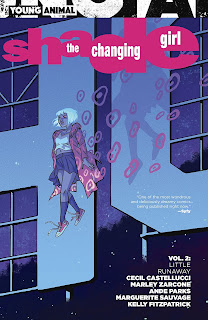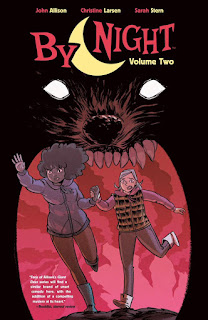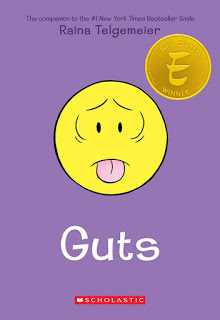Shade the Changing Girl, Vol. 2 by Cecil Castellucci, Marley Zarcone & others
First, about that “others” in the post title: Marguerite Sauvage drew one of the six issues collected here, Ande Parks inked the pages set on Meta, Kelly Fitzpatrick colored all of it, and several other artists contributed to the back-up stories. Including all of them would make it look like a law firm.
But Cecil Castellucci wrote all of it and Marley Zarcone drew all but the first issue in Shade the Changing Girl, Vol. 2: Little Runaway , so it’s reasonably fair to attribute it to the two of them. And it is, as you might guess, the immediate sequel to Vol. 1: Earth Girl Made Easy , by the same team, and concludes the initial arc of this comic. (It dove into a Young Animal crossover that had something to do with milk immediately afterward, and then reappeared, briefly, as Shade the Changing Woman.)
I thought this Shade was going to be focused on the alien-in-high-school thing, but I was wrong: the first issue here blows that up to send Loma Shade (current possessor of the M-vest, traverser of the strange interdimensional Madness between her planet Meta and Earth, minor criminal, college dropout, refugee and all-around flighty person) off on her own journey across America, in the mode of the Milligan/Bachalo Changing Man series of the ’90s.
Loma intends her journeys will go farther than that — she has a bucket list covering the whole Earth, including several things either mythological or eons-gone (like meeting dinosaurs) — but her journey turns into a quick stop in Gotham City (here entirely a stand-in for NYC, with no notable Gotham characters even appearing) and another in Los Alamos (somewhat muted; I seem to remember Milligan/Bachalo did something more pointed in their run, but I may be misremembering) on the way to Hollywood. Loma is an obsessive, and all of her love for Earth has been filtered through the ’50s TV show Life With Honey, which was a minor fad on Meta when its TV signals arrived, fifty years after it was broadcast on earth and about ten years before this story takes place.
(As a sidebar, Castellucci slyly makes it clear that Life with Honey was never a big deal for anyone but Loma. The marketing copy for the Shade books tends to take Loma’s point of view — this is the biggest hit in the galaxy! — but that very much seems not to be actually true. Loma is not a reliable narrator of anything.)
So the arc of Changing Girl turns out to be entirely about Loma chasing down the heroine of an old TV show, for her own obsessive reasons, and ending with a character reset — not unlike the multiple times that happened in the Milligan/Bachalo run, but maybe a bit more quickly. (Milligan/Bachalo ran seventy issues, with about three resets during that time.) I’m not complaining: I like seeing supposedly superhero comics focusing on obsessive, damaged people who never do anything remotely heroic or even punch anyone. I’d have liked to see Loma’s journeys have more time and space, but everything in comics these days needs to wrap up in a couple of arcs for the TPs and to make room for the next crossover, so this is probably all we ever were going to get.
Oh, and the “villains” on the Meta end do chase Loma, in a way that seems like it will be the usual mad-scientist thing, trying to Conquer The World! or something like that. It goes an entirely different way, which is amusing and welcome, but that all ends slightly rushed and uneventfully.
The art is still excellent: Sauvage’s issue in particular is a delight, in a much more comics-realistic style than Zarcone and making me think she would be awesome for a new Millie the Model or some other high-fashion book, centering on attractive women wearing attractive clothes and doing something interesting. Zarcone still works in what looks to me like a modern version of Bachalo’s Shade look from the ’90s, a nice bit of visual continuity. And Fitzpatrick’s colors are still vibrant and eye-catching, essential in a book all about “the Madness” and what it does to people.
This didn’t go as far as I hoped it would, but it has a great tone and style, and a central concern unusual in Big Two comics: about people and their connections, and (without being obvious about it) something of that what-is-the-right-thing-to-do idea that’s always so central to superhero comics.
![]()
![]()
Reposted from The Antick Musings of G.B.H. Hornswoggler, Gent.
































































